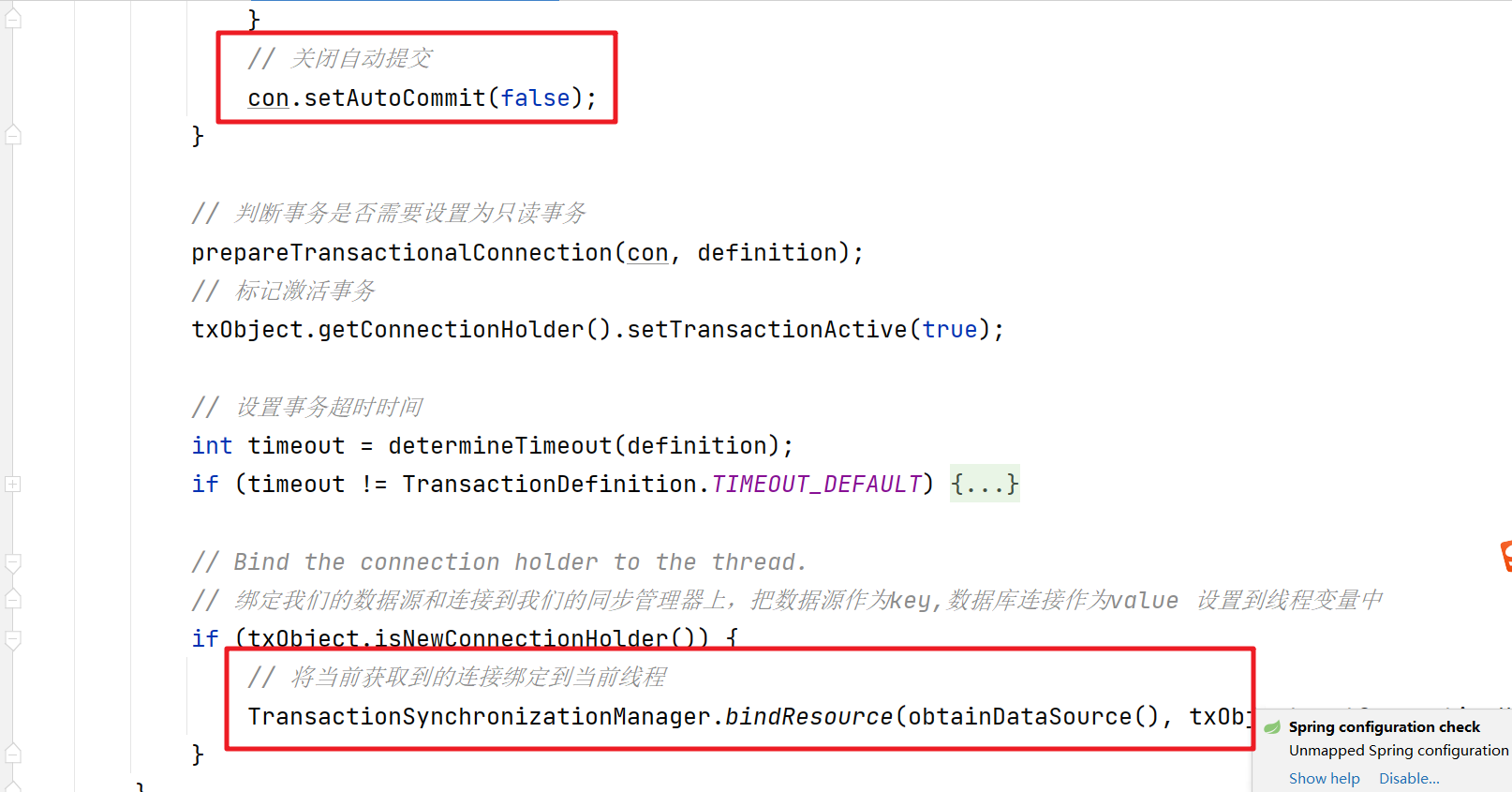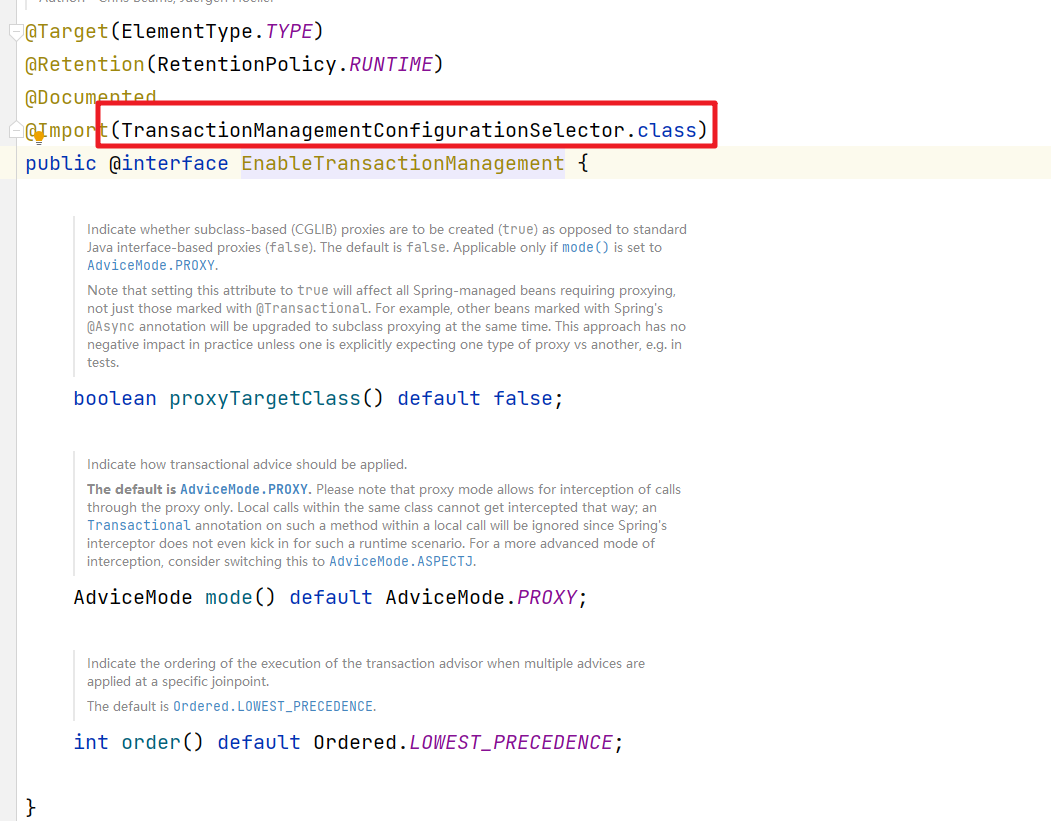文章目录
- 什么是事务
- Spring事务管理
- Spring事务实现原理
- 事务管理器
- 事务定义
- 事务的开启
- 事务核心方法
- 业务代码使用事务
- TransactionInterceptor
什么是事务
一般所指的事务是数据库事务,是指一批不可分割的数据库操作序列,也是数据库并发控制的基本单位。其执行的结果必须使数据库从一种一致性状态到另一种一致性状态。事务必须满足4个基本特性,即ACID(原子性、一致性、隔离性、持久性)。
Spring事务管理
Spring并不直接支持事务,只有当数据库支持事务时,Spring才支持。他只是通过AOP简化了开发人员使用事务的步骤。
Spring可通过xml和注解配置和一些关键类,确保bean中涉及数据库操作的方法执行符合事务的基本特性。
例如:一个业务调用了2个Service,他们分别操作了不同的数据表,必须确保这些数据一起成功或者一起失败。
Spring事务实现原理
首先介绍Spring中和事务实现密切相关的重要类。
事务管理器
事务管理器的顶层接口是TransactionManager。以下是他的类图。

PlatformTransactionManager:平台事务管理器
ReactiveTransactionManager:响应式编程的事务管理器
Spring中事务关注的重点是:PlatformTransactionManager,以及有他的实现类
JtaTransactionManager:支持分布式事务(单个服务中的多数据源,默认只有weblogic和websphere2个实现)
DataSourceTransactionManager:单数据源事务管理器。平时用的最多的就是这个,是分析的重点。
public interface PlatformTransactionManager extends TransactionManager {/*** 获取事务*/TransactionStatus getTransaction(@Nullable TransactionDefinition definition)throws TransactionException;/*** 提交数据*/void commit(TransactionStatus status) throws TransactionException;/*** 回滚数据*/void rollback(TransactionStatus status) throws TransactionException;}
事务定义
事务定义类为TransactionDefinition,在事务管理器获取事务时作为参数传入。它定义了事务的 传播属性,隔离级别,超时时间,是否只读等属性。
public interface TransactionDefinition {/*** 支持当前事务,若当前没有事务就创建一个事务*/int PROPAGATION_REQUIRED = 0;/*** 如果当前存在事务,则加入该事务;如果当前没有事务,则以非事务的方式运行 */int PROPAGATION_SUPPORTS = 1;/*** 如果当前存在事务,则加入该事务;如果当前没有事务,则抛出异常*/int PROPAGATION_MANDATORY = 2;/*** 创建一个新的事务,如果当前存在事务,则把当前事务挂起*/int PROPAGATION_REQUIRES_NEW = 3;/*** 以非事务方式运行,如果当前存在事务,则把当前事务挂起*/int PROPAGATION_NOT_SUPPORTED = 4;/*** 以非事务方式运行,如果当前存在事务,则抛出异常*/int PROPAGATION_NEVER = 5;/*** 如果外层存在事务,就以嵌套事务运行,被嵌套的事务可以独立于外层事务进行提交或者回滚(保存点),* 如果外层不存在事务,行为跟PROPAGATION_REQUIRES_NEW*/int PROPAGATION_NESTED = 6;/*** 使用数据库默认的隔离级别*/int ISOLATION_DEFAULT = -1;/*** 读未提交*/int ISOLATION_READ_UNCOMMITTED = 1; // same as java.sql.Connection.TRANSACTION_READ_UNCOMMITTED;/*** 读已提交*/int ISOLATION_READ_COMMITTED = 2; // same as java.sql.Connection.TRANSACTION_READ_COMMITTED;/*** 可重复读*/int ISOLATION_REPEATABLE_READ = 4; // same as java.sql.Connection.TRANSACTION_REPEATABLE_READ;/*** 可串行化*/int ISOLATION_SERIALIZABLE = 8; // same as java.sql.Connection.TRANSACTION_SERIALIZABLE;/*** 使用默认的超时时间*/int TIMEOUT_DEFAULT = -1;/*** 获取事务的传播行为*/default int getPropagationBehavior() {return PROPAGATION_REQUIRED;}/*** 获取事务的隔离级别*/default int getIsolationLevel() {return ISOLATION_DEFAULT;}/*** 获取事务的超时时间*/default int getTimeout() {return TIMEOUT_DEFAULT;}/*** 是否为只读事务*/default boolean isReadOnly() {return false;}/*** 获取当前事务的名称*/@Nullabledefault String getName() {return null;}static TransactionDefinition withDefaults() {return StaticTransactionDefinition.INSTANCE;}}
TransactionDefinition的体系结构

DefaultTransactionDefinition:是事务定义的默认实现
DefaultTransactionAttribute:扩展了TransactionAttribute中的属性的实现
@Transactional:该组件会被解析加载为对应的 TransactionDefinition对象。
事务的开启
在PlatformTransactionManager中获取事务的时候返回的是TransactionStatus对象。我们来看看这个对象。


子类中扩展了

事务核心方法
事务核心方法: AbstractPlatformTransactionManager.getTransaction()
/*** This implementation handles propagation behavior. Delegates to* {@code doGetTransaction}, {@code isExistingTransaction}* and {@code doBegin}.* @see #doGetTransaction* @see #isExistingTransaction* @see #doBegin*/@Overridepublic final TransactionStatus getTransaction(@Nullable TransactionDefinition definition)throws TransactionException {// Use defaults if no transaction definition given.// 如果没有事务定义信息则使用默认的事务管理器定义信息TransactionDefinition def = (definition != null ? definition : TransactionDefinition.withDefaults());// 获取事务Object transaction = doGetTransaction();boolean debugEnabled = logger.isDebugEnabled();// 判断当前线程是否存在事务,判断依据为当前线程记录的连接不为空且连接中的transactionActive属性不为空if (isExistingTransaction(transaction)) {// Existing transaction found -> check propagation behavior to find out how to behave.// 当前线程已经存在事务return handleExistingTransaction(def, transaction, debugEnabled);}// Check definition settings for new transaction.// 事务超时设置验证if (def.getTimeout() < TransactionDefinition.TIMEOUT_DEFAULT) {throw new InvalidTimeoutException("Invalid transaction timeout", def.getTimeout());}// No existing transaction found -> check propagation behavior to find out how to proceed.// 如果当前线程不存在事务,但是PropagationBehavior却被声明为PROPAGATION_MANDATORY抛出异常if (def.getPropagationBehavior() == TransactionDefinition.PROPAGATION_MANDATORY) {throw new IllegalTransactionStateException("No existing transaction found for transaction marked with propagation 'mandatory'");}// PROPAGATION_REQUIRED,PROPAGATION_REQUIRES_NEW,PROPAGATION_NESTED都需要新建事务else if (def.getPropagationBehavior() == TransactionDefinition.PROPAGATION_REQUIRED ||def.getPropagationBehavior() == TransactionDefinition.PROPAGATION_REQUIRES_NEW ||def.getPropagationBehavior() == TransactionDefinition.PROPAGATION_NESTED) {//没有当前事务的话,REQUIRED,REQUIRES_NEW,NESTED挂起的是空事务,然后创建一个新事务SuspendedResourcesHolder suspendedResources = suspend(null);if (debugEnabled) {logger.debug("Creating new transaction with name [" + def.getName() + "]: " + def);}try {return startTransaction(def, transaction, debugEnabled, suspendedResources);}catch (RuntimeException | Error ex) {// 恢复挂起的事务resume(null, suspendedResources);throw ex;}}else {// Create "empty" transaction: no actual transaction, but potentially synchronization.// 创建一个空的事务if (def.getIsolationLevel() != TransactionDefinition.ISOLATION_DEFAULT && logger.isWarnEnabled()) {logger.warn("Custom isolation level specified but no actual transaction initiated; " +"isolation level will effectively be ignored: " + def);}boolean newSynchronization = (getTransactionSynchronization() == SYNCHRONIZATION_ALWAYS);return prepareTransactionStatus(def, null, true, newSynchronization, debugEnabled, null);}}
其中关键的方法:doGetTransaction()方法,有很多不同的实现类。我们来看下DataSourceTransactionManager的
/*** 创建一个DataSourceTransactionObject当作事务,设置是否允许保存点,然后获取连接持有器ConnectionHolder* 里面会存放JDBC的连接,设置给DataSourceTransactionObject,当然第一次是空的** @return*/@Overrideprotected Object doGetTransaction() {// 创建一个数据源事务对象DataSourceTransactionObject txObject = new DataSourceTransactionObject();// 是否允许当前事务设置保持点txObject.setSavepointAllowed(isNestedTransactionAllowed());/*** TransactionSynchronizationManager 事务同步管理器对象(该类中都是局部线程变量)* 用来保存当前事务的信息,我们第一次从这里去线程变量中获取 事务连接持有器对象 通过数据源为key去获取* 由于第一次进来开始事务 我们的事务同步管理器中没有被存放.所以此时获取出来的conHolder为null*/ConnectionHolder conHolder =(ConnectionHolder) TransactionSynchronizationManager.getResource(obtainDataSource());// 非新创建连接则写falsetxObject.setConnectionHolder(conHolder, false);// 返回事务对象return txObject;}
然后事务管理的代码
/*** Create a TransactionStatus for an existing transaction.*/private TransactionStatus handleExistingTransaction(TransactionDefinition definition, Object transaction, boolean debugEnabled)throws TransactionException {/*** 判断当前的事务行为是不是PROPAGATION_NEVER的* 表示为不支持事务,但是当前又存在一个事务,所以抛出异常*/if (definition.getPropagationBehavior() == TransactionDefinition.PROPAGATION_NEVER) {throw new IllegalTransactionStateException("Existing transaction found for transaction marked with propagation 'never'");}/*** 判断当前的事务属性不支持事务,PROPAGATION_NOT_SUPPORTED,所以需要先挂起已经存在的事务*/if (definition.getPropagationBehavior() == TransactionDefinition.PROPAGATION_NOT_SUPPORTED) {if (debugEnabled) {logger.debug("Suspending current transaction");}// 挂起当前事务Object suspendedResources = suspend(transaction);boolean newSynchronization = (getTransactionSynchronization() == SYNCHRONIZATION_ALWAYS);// 创建一个新的非事务状态(保存了上一个存在事务状态的属性)return prepareTransactionStatus(definition, null, false, newSynchronization, debugEnabled, suspendedResources);}/*** 当前的事务属性状态是PROPAGATION_REQUIRES_NEW表示需要新开启一个事务状态*/if (definition.getPropagationBehavior() == TransactionDefinition.PROPAGATION_REQUIRES_NEW) {if (debugEnabled) {logger.debug("Suspending current transaction, creating new transaction with name [" +definition.getName() + "]");}// 挂起当前事务并返回挂起的资源持有器SuspendedResourcesHolder suspendedResources = suspend(transaction);try {// 创建一个新的非事务状态(保存了上一个存在事务状态的属性)return startTransaction(definition, transaction, debugEnabled, suspendedResources);}catch (RuntimeException | Error beginEx) {resumeAfterBeginException(transaction, suspendedResources, beginEx);throw beginEx;}}// 嵌套事务if (definition.getPropagationBehavior() == TransactionDefinition.PROPAGATION_NESTED) {// 不允许就报异常if (!isNestedTransactionAllowed()) {throw new NestedTransactionNotSupportedException("Transaction manager does not allow nested transactions by default - " +"specify 'nestedTransactionAllowed' property with value 'true'");}if (debugEnabled) {logger.debug("Creating nested transaction with name [" + definition.getName() + "]");}// 嵌套事务的处理if (useSavepointForNestedTransaction()) {// Create savepoint within existing Spring-managed transaction,// through the SavepointManager API implemented by TransactionStatus.// Usually uses JDBC 3.0 savepoints. Never activates Spring synchronization.// 如果没有可以使用保存点的方式控制事务回滚,那么在嵌入式事务的建立初始简历保存点DefaultTransactionStatus status =prepareTransactionStatus(definition, transaction, false, false, debugEnabled, null);// 为事务设置一个回退点status.createAndHoldSavepoint();return status;}else {// Nested transaction through nested begin and commit/rollback calls.// Usually only for JTA: Spring synchronization might get activated here// in case of a pre-existing JTA transaction.// 有些情况是不能使用保存点操作return startTransaction(definition, transaction, debugEnabled, null);}}// Assumably PROPAGATION_SUPPORTS or PROPAGATION_REQUIRED.if (debugEnabled) {logger.debug("Participating in existing transaction");}if (isValidateExistingTransaction()) {if (definition.getIsolationLevel() != TransactionDefinition.ISOLATION_DEFAULT) {Integer currentIsolationLevel = TransactionSynchronizationManager.getCurrentTransactionIsolationLevel();if (currentIsolationLevel == null || currentIsolationLevel != definition.getIsolationLevel()) {Constants isoConstants = DefaultTransactionDefinition.constants;throw new IllegalTransactionStateException("Participating transaction with definition [" +definition + "] specifies isolation level which is incompatible with existing transaction: " +(currentIsolationLevel != null ?isoConstants.toCode(currentIsolationLevel, DefaultTransactionDefinition.PREFIX_ISOLATION) :"(unknown)"));}}if (!definition.isReadOnly()) {if (TransactionSynchronizationManager.isCurrentTransactionReadOnly()) {throw new IllegalTransactionStateException("Participating transaction with definition [" +definition + "] is not marked as read-only but existing transaction is");}}}boolean newSynchronization = (getTransactionSynchronization() != SYNCHRONIZATION_NEVER);return prepareTransactionStatus(definition, transaction, false, newSynchronization, debugEnabled, null);}
最后来看看 startTransaction() 方法
/*** Start a new transaction.*/private TransactionStatus startTransaction(TransactionDefinition definition, Object transaction,boolean debugEnabled, @Nullable SuspendedResourcesHolder suspendedResources) {// 是否需要新同步boolean newSynchronization = (getTransactionSynchronization() != SYNCHRONIZATION_NEVER);// 创建新的事务DefaultTransactionStatus status = newTransactionStatus(definition, transaction, true, newSynchronization, debugEnabled, suspendedResources);// 开启事务和连接doBegin(transaction, definition);// 新同步事务的设置,针对于当前线程的设置prepareSynchronization(status, definition);return status;}
doBegin方法开启和连接事务
@Overrideprotected void doBegin(Object transaction, TransactionDefinition definition) {// 强制转化事务对象DataSourceTransactionObject txObject = (DataSourceTransactionObject) transaction;Connection con = null;try {// 判断事务对象没有数据库连接持有器if (!txObject.hasConnectionHolder() ||txObject.getConnectionHolder().isSynchronizedWithTransaction()) {// 通过数据源获取一个数据库连接对象Connection newCon = obtainDataSource().getConnection();if (logger.isDebugEnabled()) {logger.debug("Acquired Connection [" + newCon + "] for JDBC transaction");}// 把我们的数据库连接包装成一个ConnectionHolder对象 然后设置到我们的txObject对象中去txObject.setConnectionHolder(new ConnectionHolder(newCon), true);}// 标记当前的连接是一个同步事务txObject.getConnectionHolder().setSynchronizedWithTransaction(true);con = txObject.getConnectionHolder().getConnection();// 为当前的事务设置隔离级别Integer previousIsolationLevel = DataSourceUtils.prepareConnectionForTransaction(con, definition);// 设置先前隔离级别txObject.setPreviousIsolationLevel(previousIsolationLevel);// 设置是否只读txObject.setReadOnly(definition.isReadOnly());// Switch to manual commit if necessary. This is very expensive in some JDBC drivers,// so we don't want to do it unnecessarily (for example if we've explicitly// configured the connection pool to set it already).// 关闭自动提交if (con.getAutoCommit()) {//设置需要恢复自动提交txObject.setMustRestoreAutoCommit(true);if (logger.isDebugEnabled()) {logger.debug("Switching JDBC Connection [" + con + "] to manual commit");}// 关闭自动提交con.setAutoCommit(false);}// 判断事务是否需要设置为只读事务prepareTransactionalConnection(con, definition);// 标记激活事务txObject.getConnectionHolder().setTransactionActive(true);// 设置事务超时时间int timeout = determineTimeout(definition);if (timeout != TransactionDefinition.TIMEOUT_DEFAULT) {txObject.getConnectionHolder().setTimeoutInSeconds(timeout);}// Bind the connection holder to the thread.// 绑定我们的数据源和连接到我们的同步管理器上,把数据源作为key,数据库连接作为value 设置到线程变量中if (txObject.isNewConnectionHolder()) {// 将当前获取到的连接绑定到当前线程TransactionSynchronizationManager.bindResource(obtainDataSource(), txObject.getConnectionHolder());}}catch (Throwable ex) {if (txObject.isNewConnectionHolder()) {// 释放数据库连接DataSourceUtils.releaseConnection(con, obtainDataSource());txObject.setConnectionHolder(null, false);}throw new CannotCreateTransactionException("Could not open JDBC Connection for transaction", ex);}}
注意:在上述doBegin方法源码中的第42行关闭了自动提交,同时第60行把连接绑定到本地线程中bindResource方法
业务代码使用事务
业务代码使用事务的方式有如下2种,一种是编程式事务,另一种是AOP事务。
编程式事务
编程式事务要求开发人员手动使用事务管理器,创建事务,开始事务和结束事务。Spring只需要提前配置并实例化好事务管理器Bean,然后注入到Service中即可。参考如下案例代码:insertUser()方法为主要业务方法,其中调用了2个方法分别负责插入用户和插入业务日志。
@Autowiredprivate UserDao userDao;@Autowiredprivate PlatformTransactionManager txManager;@Autowiredprivate LogService logService;@Transactionalpublic void insertUser(User u) {// 1、创建事务定义DefaultTransactionDefinition definition = new DefaultTransactionDefinition();// 2、根据定义开启事务TransactionStatus status = txManager.getTransaction(definition);try {this.userDao.insert(u);Log log = new Log(System.currentTimeMillis() + "", System.currentTimeMillis() + "-" + u.getUserName());// this.doAddUser(u);this.logService.insertLog(log);// 3、提交事务txManager.commit(status);} catch (Exception e) {// 4、异常了,回滚事务txManager.rollback(status);throw e;}}
AOP事务
接下来是AOP事务,给事务方法加上@Transactional注解之后。来看看在Spring中这块是如何处理的。

通过Debug的方式可以看到,在调用@Transactional标记的方法之前,Spring自动创建了Cglib代理对象,调用的是代理对象的insertUser方法,处理的关键流程 org.springframework.transaction.interceptor.TransactionInterceptor 就是事务处理的Advisor。下面是的他的invoke方法。
@Override@Nullablepublic Object invoke(MethodInvocation invocation) throws Throwable {// Work out the target class: may be {@code null}.// The TransactionAttributeSource should be passed the target class// as well as the method, which may be from an interface.Class<?> targetClass = (invocation.getThis() != null ? AopUtils.getTargetClass(invocation.getThis()) : null);// Adapt to TransactionAspectSupport's invokeWithinTransaction...return invokeWithinTransaction(invocation.getMethod(), targetClass, invocation::proceed);}
进入到TransactionAspectSupport.invokeWithinTransaction()方法中,其中第46行,会调用具体的业务方法完成事务操作。
@Nullableprotected Object invokeWithinTransaction(Method method, @Nullable Class<?> targetClass,final InvocationCallback invocation) throws Throwable {// If the transaction attribute is null, the method is non-transactional.// 获取我们的事务属性源对象TransactionAttributeSource tas = getTransactionAttributeSource();// 通过事务属性源对象获取到当前方法的事务属性信息final TransactionAttribute txAttr = (tas != null ? tas.getTransactionAttribute(method, targetClass) : null);// 获取我们配置的事务管理器对象final TransactionManager tm = determineTransactionManager(txAttr);if (this.reactiveAdapterRegistry != null && tm instanceof ReactiveTransactionManager) {ReactiveTransactionSupport txSupport = this.transactionSupportCache.computeIfAbsent(method, key -> {if (KotlinDetector.isKotlinType(method.getDeclaringClass()) && KotlinDelegate.isSuspend(method)) {throw new TransactionUsageException("Unsupported annotated transaction on suspending function detected: " + method +". Use TransactionalOperator.transactional extensions instead.");}ReactiveAdapter adapter = this.reactiveAdapterRegistry.getAdapter(method.getReturnType());if (adapter == null) {throw new IllegalStateException("Cannot apply reactive transaction to non-reactive return type: " +method.getReturnType());}return new ReactiveTransactionSupport(adapter);});return txSupport.invokeWithinTransaction(method, targetClass, invocation, txAttr, (ReactiveTransactionManager) tm);}PlatformTransactionManager ptm = asPlatformTransactionManager(tm);// 获取连接点的唯一标识 类名+方法名final String joinpointIdentification = methodIdentification(method, targetClass, txAttr);// 声明式事务处理if (txAttr == null || !(ptm instanceof CallbackPreferringPlatformTransactionManager)) {// Standard transaction demarcation with getTransaction and commit/rollback calls.// 创建TransactionInfoTransactionInfo txInfo = createTransactionIfNecessary(ptm, txAttr, joinpointIdentification);Object retVal;try {// This is an around advice: Invoke the next interceptor in the chain.// This will normally result in a target object being invoked.// 执行被增强方法,调用具体的业务处理逻辑retVal = invocation.proceedWithInvocation();}catch (Throwable ex) {// target invocation exception// 异常回滚completeTransactionAfterThrowing(txInfo, ex);throw ex;}finally {//清除事务信息,恢复线程私有的老的事务信息cleanupTransactionInfo(txInfo);}if (retVal != null && vavrPresent && VavrDelegate.isVavrTry(retVal)) {// Set rollback-only in case of Vavr failure matching our rollback rules...TransactionStatus status = txInfo.getTransactionStatus();if (status != null && txAttr != null) {retVal = VavrDelegate.evaluateTryFailure(retVal, txAttr, status);}}//成功后提交,会进行资源储量,连接释放,恢复挂起事务等操作commitTransactionAfterReturning(txInfo);return retVal;}else {// 编程式事务处理Object result;final ThrowableHolder throwableHolder = new ThrowableHolder();// It's a CallbackPreferringPlatformTransactionManager: pass a TransactionCallback in.try {result = ((CallbackPreferringPlatformTransactionManager) ptm).execute(txAttr, status -> {TransactionInfo txInfo = prepareTransactionInfo(ptm, txAttr, joinpointIdentification, status);try {Object retVal = invocation.proceedWithInvocation();if (retVal != null && vavrPresent && VavrDelegate.isVavrTry(retVal)) {// Set rollback-only in case of Vavr failure matching our rollback rules...retVal = VavrDelegate.evaluateTryFailure(retVal, txAttr, status);}return retVal;}catch (Throwable ex) {if (txAttr.rollbackOn(ex)) {// A RuntimeException: will lead to a rollback.if (ex instanceof RuntimeException) {throw (RuntimeException) ex;}else {throw new ThrowableHolderException(ex);}}else {// A normal return value: will lead to a commit.throwableHolder.throwable = ex;return null;}}finally {cleanupTransactionInfo(txInfo);}});}catch (ThrowableHolderException ex) {throw ex.getCause();}catch (TransactionSystemException ex2) {if (throwableHolder.throwable != null) {logger.error("Application exception overridden by commit exception", throwableHolder.throwable);ex2.initApplicationException(throwableHolder.throwable);}throw ex2;}catch (Throwable ex2) {if (throwableHolder.throwable != null) {logger.error("Application exception overridden by commit exception", throwableHolder.throwable);}throw ex2;}// Check result state: It might indicate a Throwable to rethrow.if (throwableHolder.throwable != null) {throw throwableHolder.throwable;}return result;}}
然后进入到createTransactionIfNecessary方法中
protected TransactionInfo createTransactionIfNecessary(@Nullable PlatformTransactionManager tm,@Nullable TransactionAttribute txAttr, final String joinpointIdentification) {// If no name specified, apply method identification as transaction name.// 如果没有名称指定则使用方法唯一标识,并使用DelegatingTransactionAttribute封装txAttrif (txAttr != null && txAttr.getName() == null) {txAttr = new DelegatingTransactionAttribute(txAttr) {@Overridepublic String getName() {return joinpointIdentification;}};}TransactionStatus status = null;if (txAttr != null) {if (tm != null) {// 获取TransactionStatus事务状态信息status = tm.getTransaction(txAttr);}else {if (logger.isDebugEnabled()) {logger.debug("Skipping transactional joinpoint [" + joinpointIdentification +"] because no transaction manager has been configured");}}}// 根据指定的属性与status准备一个TransactionInfo,return prepareTransactionInfo(tm, txAttr, joinpointIdentification, status);}
其中第19行,进入 getTransaction()这个方法,开始事务。


核心的是doBegin方法。完成 自动提交的关闭和 本地线程 对象的存储

TransactionInterceptor
既然事务是通过TransactionInterceptor来创建的。那TransactionInterceptor是如何注入到容器中的?
首先来看看事务的开启注解@EnableTransactionManagement

可以看到这个注解导入了一个TransactionManagementConfigurationSelector类。

这个TransactionManagementConfigurationSelector的selectImports方法内部,引入了一个重要类,ProxyTransactionManagementConfiguration
@Overrideprotected String[] selectImports(AdviceMode adviceMode) {switch (adviceMode) {case PROXY:return new String[] {AutoProxyRegistrar.class.getName(),ProxyTransactionManagementConfiguration.class.getName()};case ASPECTJ:return new String[] {determineTransactionAspectClass()};default:return null;}}
这个类是一个配置类,注册了事务的一些相关类,上文提到的TransactionInterceptor是其中之一。
/*** 代理事务配置,注册事务需要用的一些类,而且Role=ROLE_INFRASTRUCTURE都是属于内部级别的*/
@Configuration(proxyBeanMethods = false)
@Role(BeanDefinition.ROLE_INFRASTRUCTURE)
public class ProxyTransactionManagementConfiguration extends AbstractTransactionManagementConfiguration {/*** 配置事务属性通知器,存放事务注解的方法相关的属性* @return*/@Bean(name = TransactionManagementConfigUtils.TRANSACTION_ADVISOR_BEAN_NAME)@Role(BeanDefinition.ROLE_INFRASTRUCTURE)public BeanFactoryTransactionAttributeSourceAdvisor transactionAdvisor(TransactionAttributeSource transactionAttributeSource, TransactionInterceptor transactionInterceptor) {BeanFactoryTransactionAttributeSourceAdvisor advisor = new BeanFactoryTransactionAttributeSourceAdvisor();advisor.setTransactionAttributeSource(transactionAttributeSource);advisor.setAdvice(transactionInterceptor);if (this.enableTx != null) {advisor.setOrder(this.enableTx.<Integer>getNumber("order"));}return advisor;}@Bean@Role(BeanDefinition.ROLE_INFRASTRUCTURE)public TransactionAttributeSource transactionAttributeSource() {return new AnnotationTransactionAttributeSource();}/*** 配置事务拦截器,实现了方法拦截器*/@Bean@Role(BeanDefinition.ROLE_INFRASTRUCTURE)public TransactionInterceptor transactionInterceptor(TransactionAttributeSource transactionAttributeSource) {TransactionInterceptor interceptor = new TransactionInterceptor();interceptor.setTransactionAttributeSource(transactionAttributeSource);if (this.txManager != null) {interceptor.setTransactionManager(this.txManager);}return interceptor;}
}
到这分析结束。




-每天10个知识点)


)
)







![[Qt]QListView 重绘实例之一:背景重绘](http://pic.xiahunao.cn/[Qt]QListView 重绘实例之一:背景重绘)


